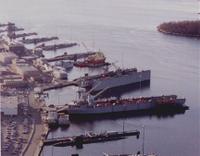How much will it really cost to clean the base?
 How much it will cost to clean up the sub base in Groton if the military closes the facility. The U.S. Navy and the U.S. Department of Enviromental Protection can't seen to agree on how much it wil cost to clean up the place. One has to wonder how much the cleanup is going to cost average taxpayer (you can bet no one wants to answer that question). Whatever the agreeed estimated pricetag turns out to be, if I was a betting man, I'd automatically double that amount.
How much it will cost to clean up the sub base in Groton if the military closes the facility. The U.S. Navy and the U.S. Department of Enviromental Protection can't seen to agree on how much it wil cost to clean up the place. One has to wonder how much the cleanup is going to cost average taxpayer (you can bet no one wants to answer that question). Whatever the agreeed estimated pricetag turns out to be, if I was a betting man, I'd automatically double that amount.From the Hartford Courant:
When it comes to the proposed closure of the Naval Submarine Base in Groton, are the U.S. Navy and the state Department of Environmental Protection really looking at the same 700-acre site?On second thought, take the final estimated cost, and triple it.
There is a $133 million difference between what the two agencies say it would cost to properly address decades of environmental ravages from pollutants such as lead, diesel oil and PCBs.
Environmental cleanup has emerged as a key argument made by the state delegation fighting to keep the sub base from being mothballed. Both the DEP and the state Attorney General's office have pushed the case.
For instance, the state disputes the Navy's claim of $10 million in immediate or unavoidable cleanup costs at the base, which 15 years ago was placed on the country's federal Superfund list of worst hazardous-waste sites.
DEP analysts say the more accurate figure is four times that much - that ensuring up-to-par sealing and monitoring of all the underground tanks, some of which are larger than the typical home, would cost $1.4 million alone.
"Like a gas station, you can't just go away and leave the tanks in the ground and say we decided not to run this gas station anymore," Connecticut DEP Commissioner Gina McCarthy said.
DEP analysts believe that in making the calculations to determine the closure list, the Navy demonstrated tunnel vision by focusing on costs for Superfund areas - ignoring the adjacent grounds that suffer from their own pollutants and a host of other issues.
The result, these analysts say, is that widespread and expensive factors have been disregarded - such as a potential $35 million in pesticide work that would likely be required around some 200 buildings on base.















<< Home